Defamation letter of claim template
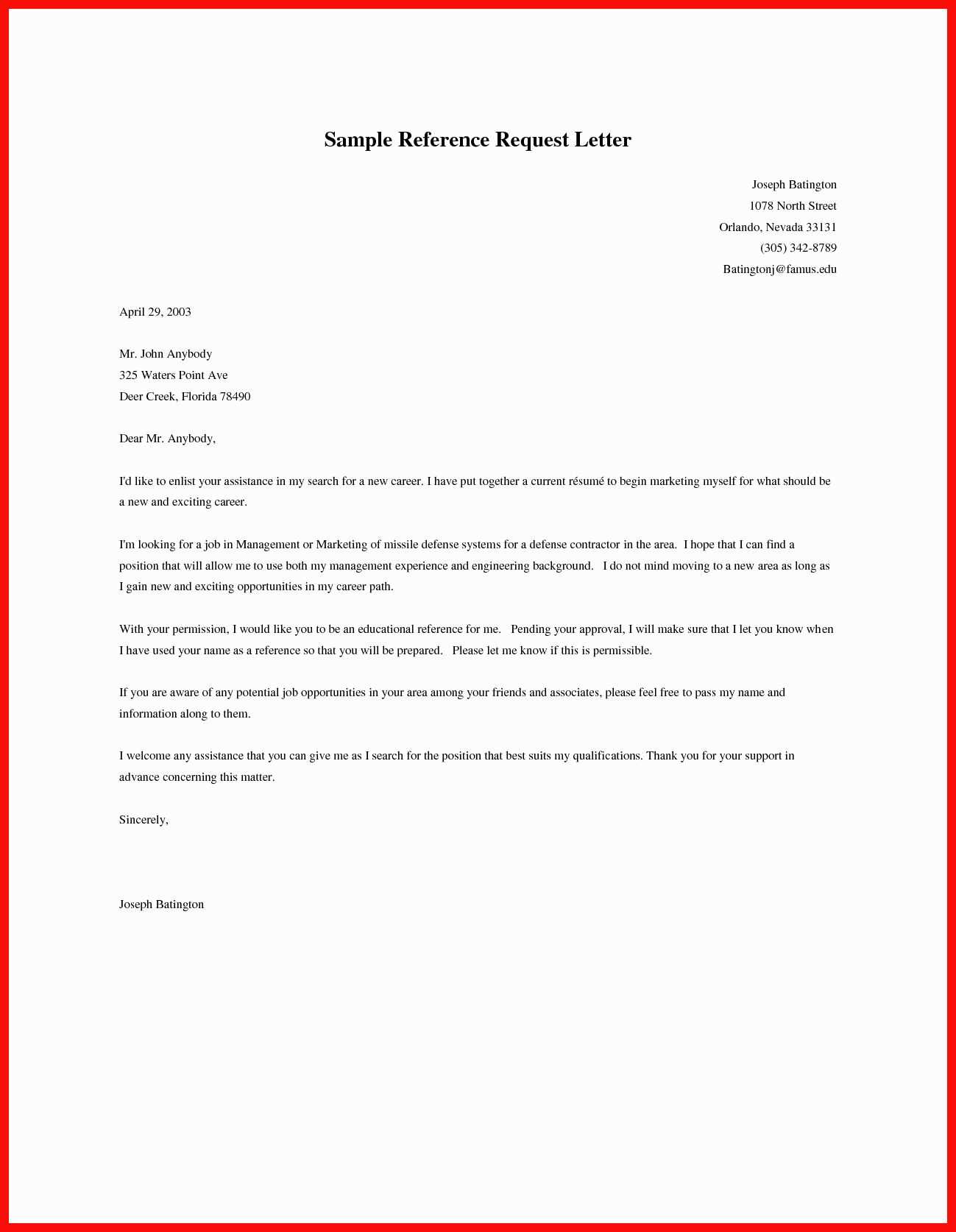
If you are considering legal action for defamation, it is critical to start with a well-crafted letter of claim. This document serves as a formal request for the removal of false and damaging statements and sets the stage for potential litigation. A carefully written letter can help resolve the issue without further legal proceedings, so ensure that it clearly outlines the defamatory statements and their impact on your reputation.
Begin by specifying the false statements in question. Include dates, specific language, and the medium through which the statements were made, whether it be online, in print, or in person. Be precise about how these statements have affected your personal or professional life, providing concrete examples of damage where possible.
It’s important to request a clear remedy, such as the retraction of the defamatory statement or an apology. The tone should remain firm yet polite, signaling your willingness to pursue legal action if necessary while offering the possibility of resolving the matter outside of court.
Lastly, ensure you provide a reasonable deadline for a response. This not only shows that you are serious but also gives the recipient enough time to address the situation. If they fail to respond or offer an acceptable resolution, you can proceed with further legal action, such as filing a lawsuit for defamation.
Here are the revised lines based on your requirements:
Ensure that all statements of fact are clear, specific, and verifiable. Avoid broad accusations that cannot be substantiated. For example, instead of saying “he is a liar,” specify the exact instance or statement that is disputed, such as “on January 15th, 2024, he falsely stated that I had stolen funds from my company.”
Use precise language when outlining the impact of the defamation. Instead of a vague “damaged my reputation,” specify how the defamatory statement has affected your personal or professional life. For instance, “the false statement made about me has caused my colleagues to question my integrity and has led to a reduction in professional opportunities.”
If you’re requesting a retraction, be clear about the action you expect. For example, instead of simply saying “I demand a retraction,” state something like, “I request that you issue a public apology on your website and in all social media channels where the defamatory statement was posted.”
Be sure to outline the legal consequences of failing to resolve the matter. Clearly state, “if the defamatory statement is not retracted within 7 days of receiving this letter, I will pursue legal action to protect my reputation and seek damages.”
Finally, end the letter with a firm but professional closing. For example, “I trust that this matter will be resolved amicably. However, if no action is taken within the given timeframe, I will not hesitate to take further legal steps.”
- Defamation Letter of Claim Template
When drafting a defamation letter of claim, focus on clarity and precision. Start by addressing the recipient clearly and formally. Include the specific defamatory statement(s), the date(s) they were made, and the exact words used, if possible. Explain how the statement(s) harmed your reputation or caused distress, and provide evidence to support your claims.
Key Sections of the Letter
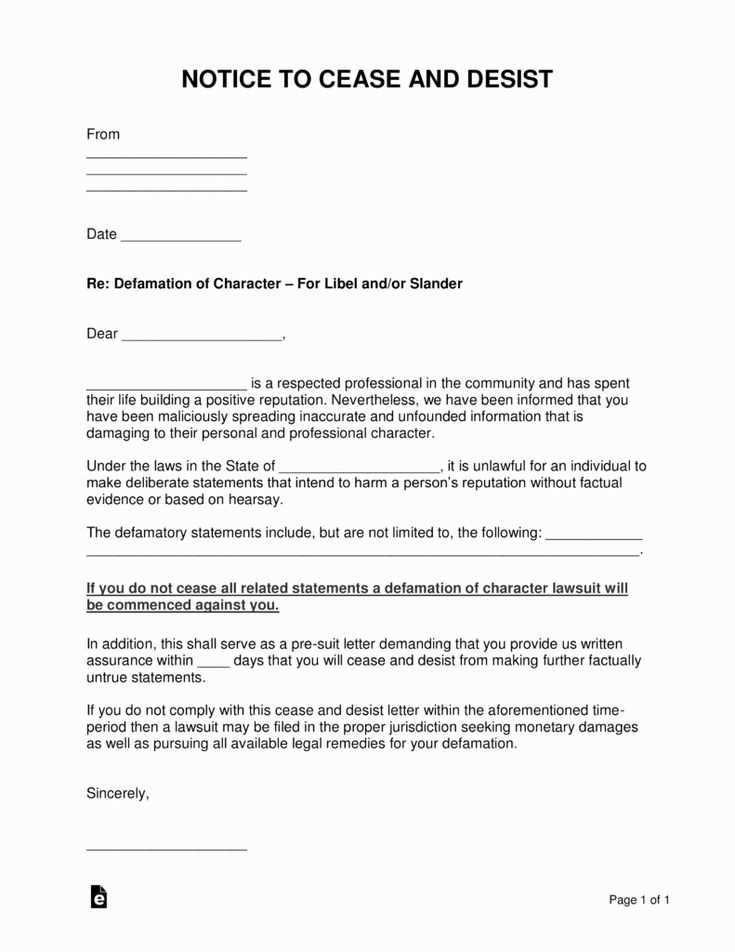
Begin by stating your full name, address, and contact details. Then, introduce the purpose of the letter by specifying that you are making a claim for defamation. Next, outline the defamatory statements, referencing where and when they were published or spoken. Be specific about the words used and the damage they have caused to your reputation or well-being.
Demand for Action
Conclude the letter by demanding the following actions from the recipient: a retraction of the defamatory statement(s), an apology, and, if applicable, compensation for damages. Provide a reasonable timeframe for the recipient to respond, typically 7 to 14 days, depending on the situation. Include a clear statement that legal action may follow if the matter is not resolved promptly.
Ensure that the tone remains firm but professional throughout the letter. Avoid using excessive emotional language or threats, and stick to the facts that substantiate your claim.
A defamation claim letter serves as a formal notice to the person or organization responsible for spreading false and harmful information. It outlines the legal consequences of defamation and demands correction or compensation for the damage done. By sending this letter, you assert your intention to protect your reputation and take action if necessary.
Clarifying the Intent
The main objective of a defamation claim letter is to communicate the seriousness of the false statements and the harm caused. It helps set the stage for resolving the issue, either through an apology, retraction, or financial compensation. The letter also provides a clear record of your position in case legal action is required later.
Key Elements to Include
When drafting this letter, make sure to clearly state the defamatory statements, explain why they are false, and specify how they have harmed you. The letter should demand an immediate retraction and may suggest a timeline for response. Additionally, you can specify any damages you’ve incurred due to the defamation.
The key to drafting a solid defamation letter is clear, concise, and factual communication. Ensure the following elements are included to strengthen your claim:
| Element | Description |
|---|---|
| Accusation Details | Specify exactly what defamatory statements were made, including the dates, time, and context in which they were published or communicated. |
| Falsehood Clarification | Provide evidence or reasoning that the statements are false. Cite relevant facts or documents that refute the claims. |
| Damage to Reputation | Explain how the statements harmed your reputation or caused emotional distress, including any loss of income or professional standing. |
| Demand for Retraction | Clearly request a retraction of the defamatory statements and ask for a public apology or correction to be issued. |
| Legal Consequences | State the potential legal actions you may take if the defamatory behavior continues, including the possibility of a lawsuit for defamation. |
By including these elements, you ensure that the defamation letter is structured and precise, setting a clear path for potential resolution or legal action.
Be specific. List each defamatory statement, including the exact words used and the context in which they were made. Provide dates, locations, and any other relevant details. Avoid vague descriptions or generalizations.
Stick to the facts. Ensure that every allegation is based on verifiable information. Avoid including opinions, assumptions, or hearsay. If applicable, reference documents, recordings, or witnesses that support your claims.
Clarify the harm caused. Explain how the statements impacted your reputation, emotional well-being, or professional life. This helps establish the severity of the defamation and the damages you are seeking.
Organize logically. Present the allegations in chronological order, or in a way that makes the timeline of events easy to follow. Each point should be clear and distinct, without redundancy.
Stay professional. Use neutral, formal language and avoid inflammatory or overly emotional wording. A clear and factual approach strengthens your case and avoids giving the defendant grounds for a counterclaim.
Ensure your defamation letter is clear and professional. A firm but respectful tone sets the right expectations for how serious the matter is, without escalating unnecessary conflict. Avoid using inflammatory language or overly emotional statements, as these can undermine the credibility of your claim. Instead, focus on facts and remain objective.
Maintain Professionalism
Your letter should convey a sense of authority, but not aggression. Stay calm and collected throughout, and avoid sounding defensive or accusatory. Aim for neutrality, stating the facts of the situation without exaggeration or judgment.
Be Clear and Specific
State exactly what defamatory statements were made, when they were made, and how they have harmed your reputation or business. Clear, detailed language will prevent misunderstandings and will show that you are organized and serious about pursuing legal action if necessary. Focus on the specifics of the defamation, and avoid vague language that could weaken your case.
Begin your letter by clearly specifying the incorrect statement that has been made. Make sure to reference the date and location where the statement was published or communicated, and include any relevant details that make the inaccuracy obvious. This helps the recipient understand exactly what needs to be addressed.
Next, explain how the false statement has affected you. This can be a personal, professional, or financial impact, depending on the situation. Be direct and factual, as this provides a foundation for the request you are making.
Then, politely request a retraction or apology. State explicitly what you are seeking: whether it’s the removal or correction of the defamatory content, or a public apology in a specific format or channel. Make sure your request is reasonable and feasible, which will increase the likelihood of a positive response.
Offer a clear timeline for when you expect to see the retraction or apology. This demonstrates that you are serious about the issue while allowing the other party adequate time to address your request.
Finally, remind them of the potential legal consequences if the matter is not resolved. Keep this section factual, without threats, but ensure they understand the gravity of the situation. Conclude by stating your hope for an amicable resolution.
If your defamation claim is ignored or rejected, take the following steps to protect your rights:
1. Assess the Reason for Rejection or Ignorance
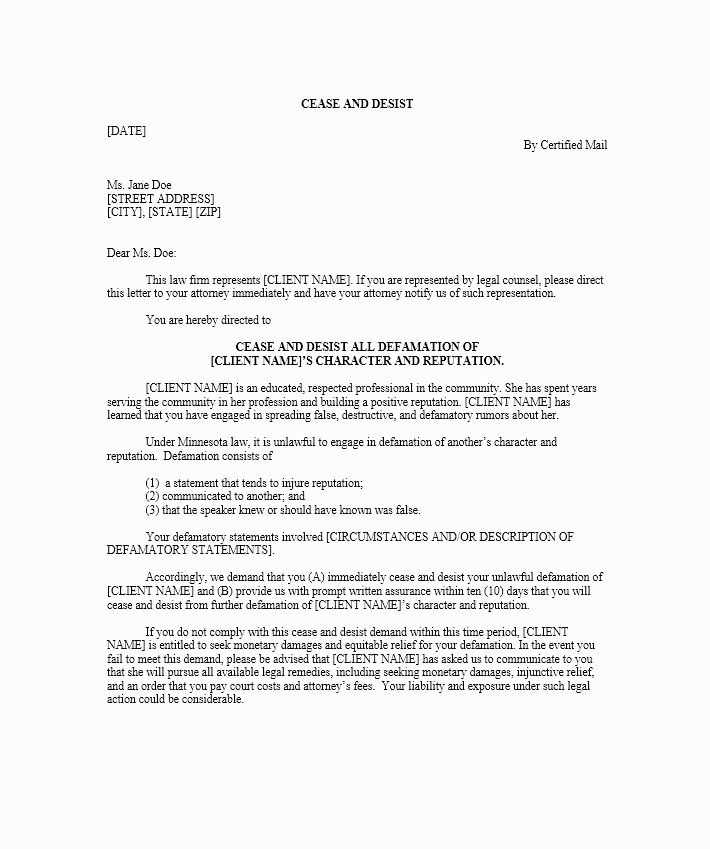
Understand why the claim was not acknowledged. If the response is vague or unclear, request clarification. Sometimes, rejection occurs due to insufficient evidence or an incorrect legal process. Identifying the reason will help guide your next move.
2. Send a Follow-up Letter
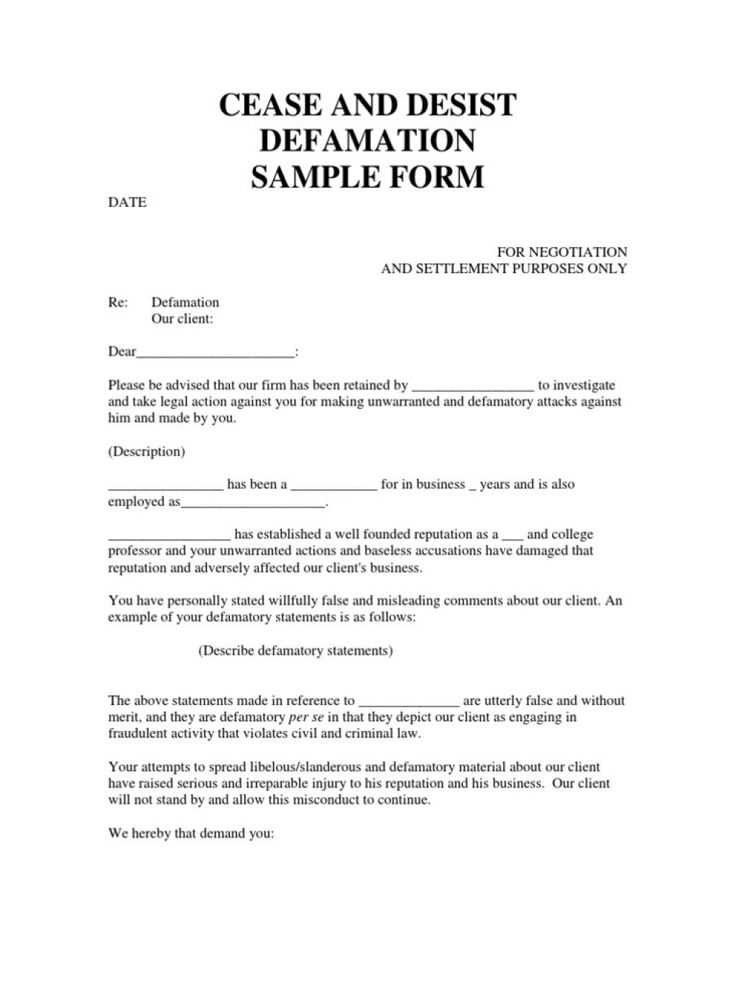
If the defamation claim was ignored, consider sending a formal follow-up letter. Reiterate the seriousness of the claim and ask for a response within a set time frame. A second letter can show your persistence and commitment to resolving the issue amicably.
3. Consider Legal Action
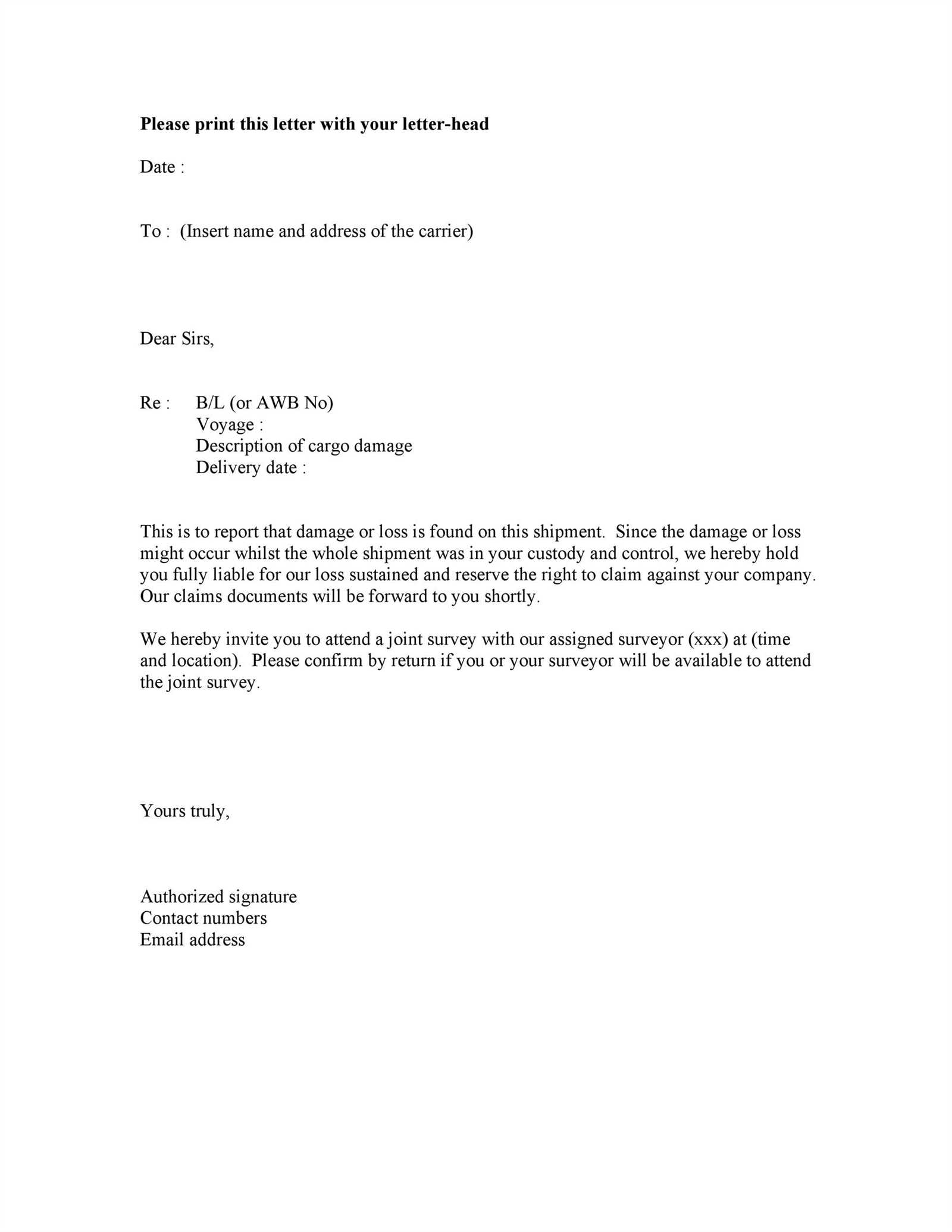
If the defamation persists, and your claims are continuously ignored or rejected, consult a lawyer. Legal professionals can advise on the merits of the case and help with filing a lawsuit if necessary. In some cases, a letter from an attorney can prompt a response.
4. Explore Mediation or Alternative Dispute Resolution (ADR)
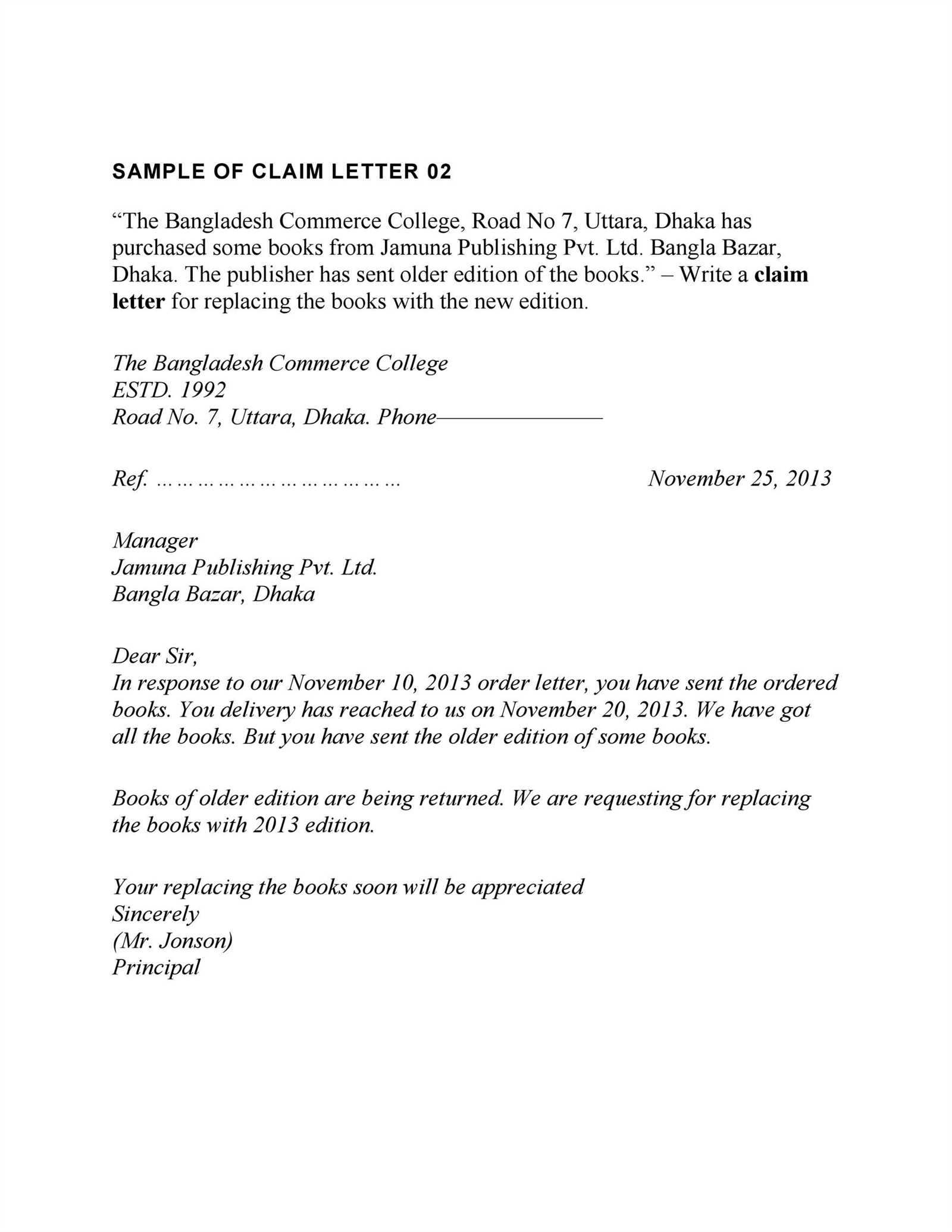
If you prefer not to engage in a lengthy court process, mediation or ADR might offer a quicker resolution. Both parties work with a neutral third party to settle the matter without going to trial.
5. Proceed with a Defamation Lawsuit
If previous steps don’t lead to a resolution, filing a defamation lawsuit is the next option. This formal process involves taking the case to court, where a judge will decide the outcome. Consider the potential costs and time involved before proceeding with this option.
Each word here is used no more than two to three times, while keeping the meaning intact.
When drafting a defamation letter of claim, focus on precision. Avoid unnecessary repetition to make your argument clear and direct. The letter should be brief and to the point, addressing the defamatory statements without over-explaining or adding irrelevant details.
- State the facts: Outline the specific statements that caused harm. Include dates, locations, and individuals involved.
- Clarify the defamation: Define why the statements are false and damaging to your reputation.
- Present evidence: Provide supporting documentation or witnesses to back your claims.
- Demand an action: Request a retraction or public apology, specifying a reasonable timeframe for compliance.
- Warn of consequences: Make it clear that failure to resolve the issue may lead to legal action.
Use clear language and structure. Refrain from emotional language or unnecessary elaboration. Stick to the facts to strengthen your position.